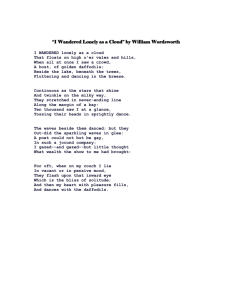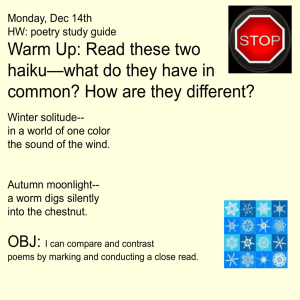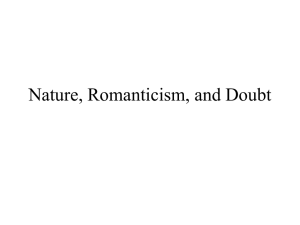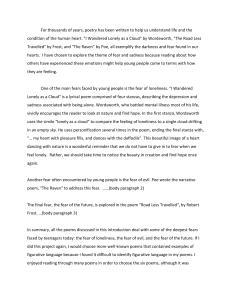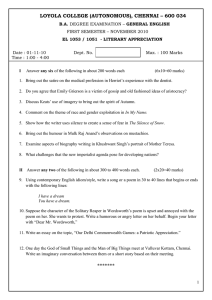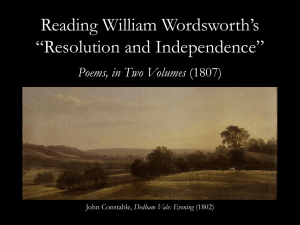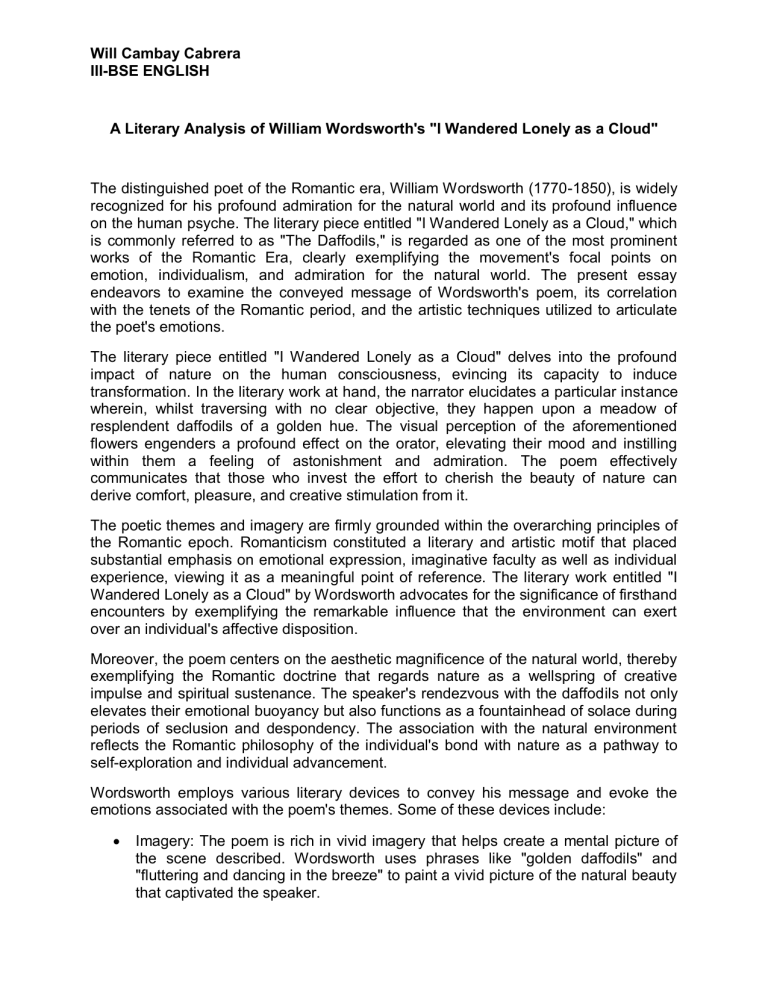
Will Cambay Cabrera III-BSE ENGLISH A Literary Analysis of William Wordsworth's "I Wandered Lonely as a Cloud" The distinguished poet of the Romantic era, William Wordsworth (1770-1850), is widely recognized for his profound admiration for the natural world and its profound influence on the human psyche. The literary piece entitled "I Wandered Lonely as a Cloud," which is commonly referred to as "The Daffodils," is regarded as one of the most prominent works of the Romantic Era, clearly exemplifying the movement's focal points on emotion, individualism, and admiration for the natural world. The present essay endeavors to examine the conveyed message of Wordsworth's poem, its correlation with the tenets of the Romantic period, and the artistic techniques utilized to articulate the poet's emotions. The literary piece entitled "I Wandered Lonely as a Cloud" delves into the profound impact of nature on the human consciousness, evincing its capacity to induce transformation. In the literary work at hand, the narrator elucidates a particular instance wherein, whilst traversing with no clear objective, they happen upon a meadow of resplendent daffodils of a golden hue. The visual perception of the aforementioned flowers engenders a profound effect on the orator, elevating their mood and instilling within them a feeling of astonishment and admiration. The poem effectively communicates that those who invest the effort to cherish the beauty of nature can derive comfort, pleasure, and creative stimulation from it. The poetic themes and imagery are firmly grounded within the overarching principles of the Romantic epoch. Romanticism constituted a literary and artistic motif that placed substantial emphasis on emotional expression, imaginative faculty as well as individual experience, viewing it as a meaningful point of reference. The literary work entitled "I Wandered Lonely as a Cloud" by Wordsworth advocates for the significance of firsthand encounters by exemplifying the remarkable influence that the environment can exert over an individual's affective disposition. Moreover, the poem centers on the aesthetic magnificence of the natural world, thereby exemplifying the Romantic doctrine that regards nature as a wellspring of creative impulse and spiritual sustenance. The speaker's rendezvous with the daffodils not only elevates their emotional buoyancy but also functions as a fountainhead of solace during periods of seclusion and despondency. The association with the natural environment reflects the Romantic philosophy of the individual's bond with nature as a pathway to self-exploration and individual advancement. Wordsworth employs various literary devices to convey his message and evoke the emotions associated with the poem's themes. Some of these devices include: Imagery: The poem is rich in vivid imagery that helps create a mental picture of the scene described. Wordsworth uses phrases like "golden daffodils" and "fluttering and dancing in the breeze" to paint a vivid picture of the natural beauty that captivated the speaker. Will Cambay Cabrera III-BSE ENGLISH Simile: The poem's opening line, "I wandered lonely as a cloud," is a simile that compares the speaker's solitude to that of a cloud floating in the sky. This simile sets the stage for the emotional transformation that occurs upon encountering the daffodils, as the speaker's loneliness is replaced by a sense of connection with the natural world. Personification: Wordsworth personifies the daffodils, describing them as "dancing" and "tossing their heads" in the breeze. This personification imbues the flowers with human-like qualities, emphasizing their ability to evoke emotional responses in the observer and further strengthening the connection between the individual and nature. Rhyme and meter: The poem follows a consistent rhyme scheme (ABABCC) and is written in iambic tetrameter, which lends a rhythmic quality to the text. This structure adds to the poem's musicality and enhances the overall reading experience. "I Wandered Lonely as a Cloud" is a quintessential Romantic poem that highlights the transformative power of nature on the human spirit. Through vivid imagery, similes, and personification, Wordsworth effectively conveys the message that nature can provide solace, joy, and inspiration to those who open themselves up to its beauty. By connecting the poem's themes to the principles of Romanticism, Wordsworth reaffirms the importance of individual experience, emotion, and the natural world in shaping human understanding and self-growth. Reference: Wordsworth, W. (1807). I wandered lonely as a cloud. In *Poems in Two Volumes*. Retrieved from https://www.poetryfoundation.org/poems/45521/i-wandered-lonely-as-a-cloud
